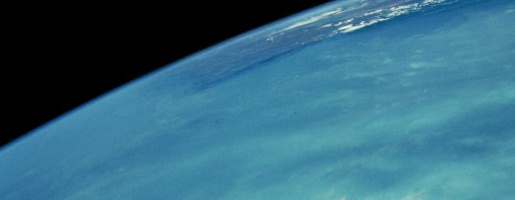 |
|||
|
The
abundant supply of flowing water makes Earth unique in the Solar System.
|
|||
| EARTH - A FRAGILE HOME | |||
| From our ground-based view, Earth seems to be immense, with huge oceans, large continents, and a deep atmosphere. With the advent of space exploration has come the understanding that our Earth is small, with a very thin atmosphere easily damaged, and a surface that could be wiped clean any day by an asteroid collision. An appreciation of the evolution of other moons and planets leads to an appreciation of our own planet's history, and the remarkable chain of events required to allow life to exist. | |||
| Orbit | |||
| Earth orbits the Sun at an average distance of 149.6 million kilometres. With an orbital eccentricity of 0.0167, the difference between perihelion and aphelion is only 5 million kilometres. This prevents large seasonal changes due to varying solar heating, and coupled with an atmosphere acting as a thermal blanket, helps keep temperatures stable. All lifeforms on the planet share the planet's orbital velocity around the Sun, an average of 29.79 kilometres per second. We all travel at 108,000 kilometres per hour | |||
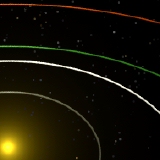 Earth's orbit. |
|||
| A thin crust | |||
| Earth is the largest and most massive of the terrestrial planets. Its rapid spin rate (23.9345 hours), coupled with a liquid iron core, enables it to generate a strong magnetic field. Most of Earth's mass is in the mantle, and most of the rest resides in the core. The mass of the crust, oceans and atmosphere make up only 0.45% the mass of the planet - we inhabit a very thin layer. | |||
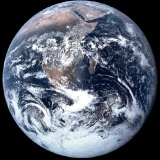 Apollo 17 view of Earth. |
|||
| Shock waves | |||
| Most of the information concerning the Earth's interior comes from studying the motion of shock waves through the planet. The interior structure also has an effect on the Earth's gravitational field, the orbits of satellites, and the magnetic field. Consequently, more is known about Earth's interior than any other planet's interior. Earth is a differentiated planet - that is, it has a layered structure consisting of a core, mantle, and crust, similar to the inner Solar System planets. | |||
 Cross-section through the Earth's interior. |
|||
| A core of iron | |||
| The magnetic field of Earth demonstrates the existence of a molten iron core. The magnetosphere is a protective feature, shielding Earth's surface from the Sun's charged particles, and protecting the atmosphere from being stripped away by the solar wind | |||
 The Aurora Borealis seen from Poker Flat, Alaska. |
|||
| More about Earth's magnetic field | |||
| Signs of life | |||
| Earth's atmosphere is unique in the Solar System as it has such a high oxygen component - a sign of life. The small amount of carbon dioxide present allows a greenhouse effect to gently warm the planet - any more and Earth could become as hot as Venus, any less and temperatures would always be freezing. The atmosphere appears to be just right to allow life to flourish - there is even a protective ozone layer that shields life from the Sun's harmful ultraviolet radiation. And yet it seems that the highest lifeforms on the planet are now slowly removing the atmosphere's protective attributes. | |||
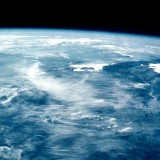 Gemini 9 photograph of cirrus clouds over the Gulf of Mexico. |
|||
| More about Earth's atmosphere | |||
| A young surface | |||
| The Earth has a young surface, constantly eroded, deformed, and renewed. A wide range of erosion processes continue to re-shape the landscape, and new features are built as a result of the motion of Earth's tectonic plates. | |||
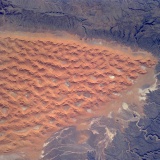 Tiferene sand dunes in Eastern Algeria. |
|||
| More about the Earth's surface | |||
| Unique tectonic plates | |||
| Earth's tectonic activity appears to be unique amongst the planets - no other planet has a surface that is still being created. The tectonic forces active within our planet have not only built mountains, broken and reformed continents, but have also altered the very atmosphere itself. | |||
 The major plates of Earth's crust. |
|||
| More about Tectonic plates | |||
| Impact Craters | |||
| Like all the other rocky bodies in the Solar System, Earth too has had its share of bombardment. In fact, the Earth's surface should look like the Moon's. That it doesn't is due to the atmosphere preventing many meteoroids from impacting, and to the erosion processes and tectonic forces constantly renewing the landscape. Nevertheless, the Earth still shows over 200 scars dating from more recent impacts, and, of course, the Earth is still a target. | |||
 Manicougan impact crater. |
|||
| More about Earth's impact craters | |||
| Terrestrial Volcanoes | |||
| Earth's active plate tectonics are responsible for the constant genesis of volcanoes - the seafloor ridges are sites of continuous crust generation. Earth's volcanoes also play a role in altering the chemical composition of the atmosphere. Active volcanoes are rare in the Solar System - only Earth and Jupiter's moon Io have fully formed major eruptions. | |||
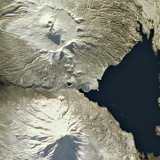 Volcanoes in Kamchatka Peninsula. |
|||
| More about Earth's volcanoes | |||
| Earth's water | |||
| Water is not unique to Earth - there are other Solar System bodies, moons and planets, that possess water. What makes Earth different is that water is very abundant, is plentiful in liquid form, and takes an active role in shaping the surface of our planet. It is of course one of the requirements for the existence of life. | |||
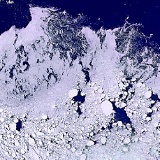 Thin ice floes, Weddell Sea, Southern Ocean. |
|||
| More about Earth's water | |||
| Earth's origin and evolution | |||
| Although the Earth formed at the same time as Venus and Mars, the final outcome has left Earth with a surface and atmosphere dramatically different. What processes have made our planet so suitable for life, and allowed Earth to avoid the fates of our neighbouring planets? | |||
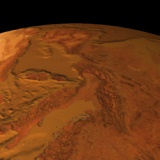 Current concern is that the future Earth may resemble early Earth. |
|||
| Earth's Satellite | |||
| Earth has only one moon, orbiting at an average distance of 384,000 kilometres. With a radius of 1738 kilometres it compares favourably with the larger moons of Jupiter and Saturn, and is larger than the planet Pluto. | |||
| As the Moon is our nearest neighbour, it has been the target of a large number of spacecraft, culminating in manned landings. The Moon is the only other Solar System object to be visited by humans. | |||
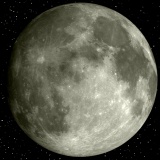 Our nearest neighbour, the Moon. |
|||
| More about the Moon | |||
| Life on Earth | |||
| We share this planet with over a million other species - life has found a way of inhabiting the most inhospitable parts of the world. Studies of lifeforms existing in the most extreme conditions may help identify possible locations of life elsewhere in the Solar System. | |||
 A carpet of green vegetation flanks the River Nile. |
|||
| More about life on Earth | |||
| Earth exploration | |||
| Astronomically speaking, exploration of the Earth effectively started with the realisation that Earth was round, and that Earth was a planet. Exploration of Earth is by no means complete, but rather than exploring new continents, the emphasis is on gaining an understanding of the workings of Earth as a system. | |||
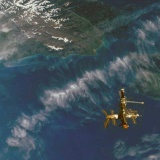 The Mir space station above New Zealand. |
|||
|
|
|||